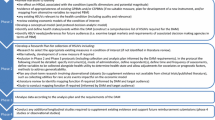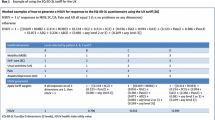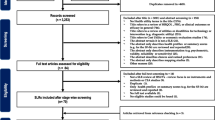Abstract
Methodological issues of how to use health state utility values (HSUVs) in decision models arise frequently, including the most appropriate evidence to use as the baseline (e.g. the baseline HSUVs associated with avoiding a particular health condition or event), how to capture changes due to adverse events and how to appropriately capture uncertainty in progressive conditions where the expected change in quality of life is likely to be monotonically decreasing over time. As preference-based measures provide different values when collected from the same patient, it is important to ensure that all HSUVs used within a single model are obtained from the same instrument where ever possible. When people enter the model without the condition of interest (e.g. primary prevention of cardiovascular disease, screening or vaccination programmes), appropriate age- and gender-adjusted HSUVs from people without the particular condition should be used as the baseline. General population norms may be used as a proxy if the exact condition-specific evidence is not available. Individual discrete health states should be used for serious adverse reactions to treatment and the corresponding HSUVs sourced as normal. Care should be taken to avoid double counting when capturing the effects for both less severe adverse reactions (e.g. itchy skin rash or dry cough) and more severe adverse events (e.g. fatigue in oncology). Transparency in reporting standards for both the justification of the evidence used and any ‘adjustments’ is important to increase readers’ confidence that the evidence used is the most appropriate available.
Similar content being viewed by others
References
Ara R, Rowen D, Mukuria C. The use of mapping to estimate health state utility values. Pharmacoeconomics. 2017. doi:10.1007/s40273-017-0548-7.
McLernon DJ, Dillon J, Donnan PT. Health-state utilities in liver disease: a systematic review. Med Decis Mak. 2008;28(4):582–92.
Si L, Winzenberg TM, de Graaff B, Palmer AJ. A systematic review and meta-analysis of utility-based quality of life for osteoporosis-related conditions. Osteoporos Int. 2014;25(8):1987–97.
Brazier J, Roberts J, Tsuchiya A, Busschbach J. A comparison of the EQ-5D and SF-6D across seven patient groups. Health Econ. 2004;13(9):873–84.
Chen J, Wong CK, McGhee SM, Pang PK, Yu WC. A comparison between the EQ-5D and the SF-6D in patients with chronic obstructive pulmonary disease (COPD). PloS One. 2014;9(11):e112389.
Wee HL, Machin D, Loke WC, Li SC, Cheung YB, Luo N, Feeny D, Fong KY, Thumboo J. Assessing differences in utility scores: a comparison of four widely used preference-based instruments. Value Health. 2007;10(4):256–65.
Whitehurst DG, Bryan S, Lewis M. Systematic review and empirical comparison of contemporaneous EQ-5D and SF-6D group mean scores. Med Decis Mak. 2011;31(6):E34–44.
Peasgood T, Ward SE, Brazier J. Health-state utility values in breast cancer. Expert Rev Pharmacoecon Outcomes Res. 2010;10(5):553–66.
Ara R, Brazier J, Peasgood T, Paisley S. The identification, review and synthesis of HSUVs from the literature. Pharmacoeconomics. 2017. doi:10.1007/s40273-017-0547-8.
Ara R, Brazier J. Estimating health state utility values for comorbidities. Pharmacoeconomics. 2017. doi:10.1007/s40273-017-0551-z.
Ara R, Brazier J. Recommended methods for the collection of HSUV evidence in clinical studies. Pharmacoeconomics. 2017. doi:10.1007/s40273-017-0549-6.
Wolowacz SE, Briggs A, Belozeroff V, Clarke P, Doward L, Goeree R, Lloyd A, Norman R. Estimating health-state utility for economic models in clinical studies: an ISPOR Good Research Practices Task Force report. Value Health. 2016;19(6):704–19.
Brazier J, Ratcliffe J, Saloman JA, Tsuchiya A. Measuring and valuing health benefits for economic evaluations. 2nd ed. Oxford: Oxford University Press; 2017.
Stojanović NA, Ignjatović I, Đenić N, Bogdanović D. Adverse effects of pharmacological therapy of benign prostatic hyperplasia on sexual function in men. Srp Arh Celok Lek. 2015;143(5–6):284–9.
Fryback DG, Lawrence WG. Dollars may not buy as many QALYs as we think: a problem with defining quality of life adjustments. MDM. 1997;17:276–84.
Ara R, Brazier JE. Using health state utility values from the general population to approximate baselines in decision analytic models when condition-specific data are not available. Value Health. 2011;14(4):539–45.
Ara R, Brazier JE. Populating an economic model with health state utility values: moving toward better practice. Value Health. 2010;13(5):509–18.
Briggs AH, Bhatt DL, Scirica BM, Raz I, Johnston KM, Szabo SM, Bergenheim K, Mukherjee J, Hirshberg B, Mosenzon O. Health-related quality-of-life implications of cardiovascular events in individuals with type 2 diabetes mellitus: a subanalysis from the Saxagliptin Assessment of Vascular Outcomes Recorded in patients with diabetes mellitus (SAVOR)-TIMI 53 trial. Diabetes Res Clin Pract. 2017.
https://discover.ukdataservice.ac.uk/series/?sn=2000021. Accessed 12 Mar 2017.
Cabases J, Janssen B, Szende A. Self-reported population health: an international perspective based on EQ-5D. New York: Springer; 2014.
Craig D, McDaid C, Fonseca T, Stock C, Woolacott N. Are adverse effects incorporated in economic models? An initial review of current practice. Health Technol Assess. 2009;13(62):1–181 (iii).
Deng. Serious adverse events (SAE) vs severe adverse events. On biostatistics and clinical trials 2011. Weblog. http://onbiostatistics.blogspot.co.uk/2011/12/serious-adverse-events-sae-vs-severe.html. Accessed 23 Sept 2016.
Sibille M, Patat A, Caplain H, Donazzolo Y. A safety grading scale to support dose escalation and define stopping rules for healthy subject first-entry-into-man studies: some point to consider form the French Club Phase 1 working group. Br J Clin Pharmacol. 2010;70(5):736–84.
Ara R, Wailoo J. NICE DSU technical support document 12: the use of health state utility values in decision models. London: National Health Service, 2011. http://www.nicedsu.org.uk.
Guide to the methods of technology appraisal, 2008. http://www.nice.org.uk. Accessed 12 Mar 2017
NICE (National Institute for Health and Care Excellence). Highly specialised technologies evaluation: sebelipase alfa for treating lysosomal acid lipase deficiency (ID 737). https://www.nice.org.uk/guidance/indevelopment/gid-lysosomalacidlipasedeficiencysebelipasealfaid737. Accessed 17 Mar 2017. Committee papers. London: National Health Service (in progress) (2016). https://www.nice.org.uk/guidance/GID-LYSOSOMALACIDLIPASEDEFICIENCYSEBELIPASEALFAID737/documents/committee-papers
Rowen D, Brazier J, Ara R, Azzabi Zouraq I. The role of condition-specific preference-based measures. Pharmacoeconomics. 2017. doi:10.1007/s40273-017-0546-9.
Gray A, Rivero-Areas O, Leal J, Dakin H, Ramos-Goni JM. How important is parameter uncertainty around the UK EQ-5D-3L value set when estimating treatment effects? Presentation 3rd joint CES/HESG meeting, Marseille; 2012.
Stevenson MD et al. Personal communication. (2016) (currently in progress, contact authors of this report or m.d.stevenson@sheffield.ac.uk directly if more information is required).
Acknowledgements
The authors would like to thank Prof. Jon Karnon, PhD, of the University of Adelaide and Dr. Andrew Lloyd, PhD, of Bladon Associates Ltd for their editorial review.
Author information
Authors and Affiliations
Contributions
RA reviewed the literature, wrote the first and subsequent drafts and edited the final draft of the manuscript. IAZ made significant edits to interim and final drafts of the manuscript. JEB made substantial contributions to the initial draft and edits to the final draft of the manuscript.
Corresponding author
Ethics declarations
Funding
This study was funded by an unrestricted grant from Takeda Pharmaceuticals International AG.
Conflict of interest
Ismail Azzabi Zouraq is employed by Takeda. Roberta Ara has no conflicts of interest. John Brazier has no conflicts of interest.
Disclosure statement
This article is published in a special edition journal supplement wholly funded by Takeda Pharmaceuticals International AG, Zurich, Switzerland.
Rights and permissions
About this article
Cite this article
Ara, R., Brazier, J. & Zouraq, I.A. The Use of Health State Utility Values in Decision Models. PharmacoEconomics 35 (Suppl 1), 77–88 (2017). https://doi.org/10.1007/s40273-017-0550-0
Published:
Issue Date:
DOI: https://doi.org/10.1007/s40273-017-0550-0






